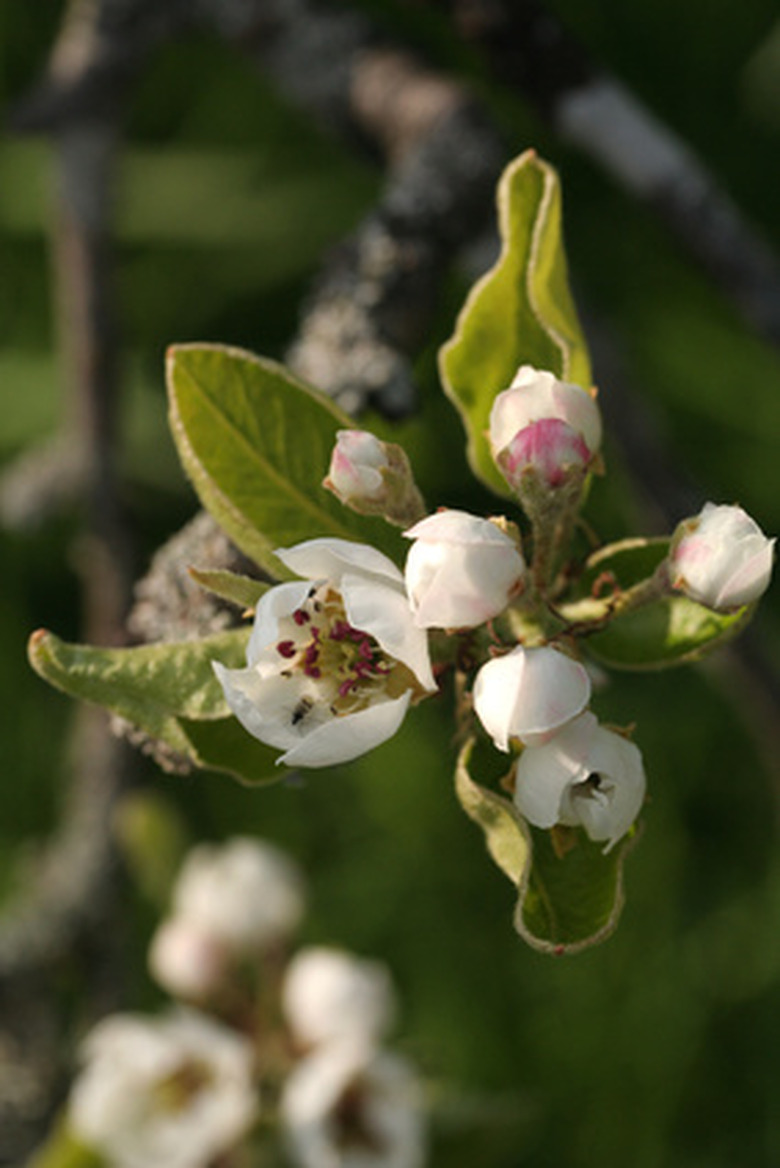How To Transplant Bradford Pear Trees
Things Needed
- Measuring tape
- Spade
- Burlap
- 1-40 qt. bag compost
- Tarp
- Wood chip mulch
Native to Korea and China, the Bradford pear (Pyrus calleryana) was introduced commercially to the United States in 1963. Landscapers and homeowners appreciated the tree's vigorous growth, compact branches and white flowers. Additionally, the tree tolerates poor soils and pollution so it was frequently planted as a street tree in cities. Recently, though, the Bradford Pear has fallen out of favor. The tree's weak wood and poor branch structure make it susceptible to ice and wind damage.
Digging Up a Bradford Pear Tree
Step 1
Water the tree two to three days before transplanting it. Don't allow the roots to dry out during the transplanting process. For best results, transplant in the spring, as soon as the ground can be worked.
- Native to Korea and China, the Bradford pear (Pyrus calleryana) was introduced commercially to the United States in 1963.
- Additionally, the tree tolerates poor soils and pollution so it was frequently planted as a street tree in cities.
Step 2
Determine the size of the rootball you need for successful transplanting. Bradford Pear trees need 12 inches of rootball for every 1 inch of trunk diameter. For example, to transplant a tree with a trunk diameter of 4 inches, measure 48 inches out from the trunk of the tree.
Step 3
Dig a trench 15 to 24 inches deep around the tree, at the previously determined measurement. Cut through the roots with a sharp spade or pruning shears. Transplanting is very stressful for trees, but digging a large rootball can minimize damage.
Step 4
Place your spade under the rootball. Gently rock the spade handle back and forth by applying pressure to the handle, until the rootball is dislodged from the ground.
- Determine the size of the rootball you need for successful transplanting.
Step 5
Place your hands under the rootball and lift it out of the ground. Don't pull it out by its trunk. Wrap the rootball in damp burlap if you are unable to plant it right away.
Planting a Bradford Pear Tree
Step 1
Select a replanting site. Choose a sheltered area protected from freezing snow and winds. Ideal locations include near other trees or near a house. The site should be in full sun, with well-drained soil.
- Place your hands under the rootball and lift it out of the ground.
Step 2
Measure the tree's rootball, both width and height with a measuring tape.
Step 3
Dig a hole with your shovel two or three times the width of the rootball and the same depth. Measure the hole with your measuring tape to ensure you've dug to the correct depth and width. Set the soil you remove from the hole to the side on a tarp.
Step 4
Place the Bradford pear tree in the hole so it stands upright and straight. The top of the rootball should sit 1 to 2 inches above the surrounding soil. If it doesn't, remove the tree and add more soil to the bottom of the hole.
- Measure the tree's rootball, both width and height with a measuring tape.
Step 5
Mix 3 to 4 shovelfuls of compost into the soil you previously dug up. Backfill the soil and compost into the hole until the hole is half full.
Step 6
Fill the hole half full with water and allow it to drain. Fill the hole with the remaining soil and mound it around the base of the tree slightly. Tamp down on the soil with your foot to remove any air pockets. Place a 1-inch layer of mulch around the tree to protect it from moisture loss.
Tip
According to the North Dakota State University Extension Office, trees transplanted in a nursery undergo transplanting techniques that minimize shock. Transplanting trees successfully is difficult for the homegrower. The younger the tree, the more likely the transplant will be successful. Prune Bradford pear trees annually in early spring to thin out branches. The branches typically grow too close together, causing them to break easily in the wind. Consider the "Cleveland Select" pear tree as a sturdier alternative to the Bradford Pear, or choose other flowering trees such as crab apple and flowering plum.
